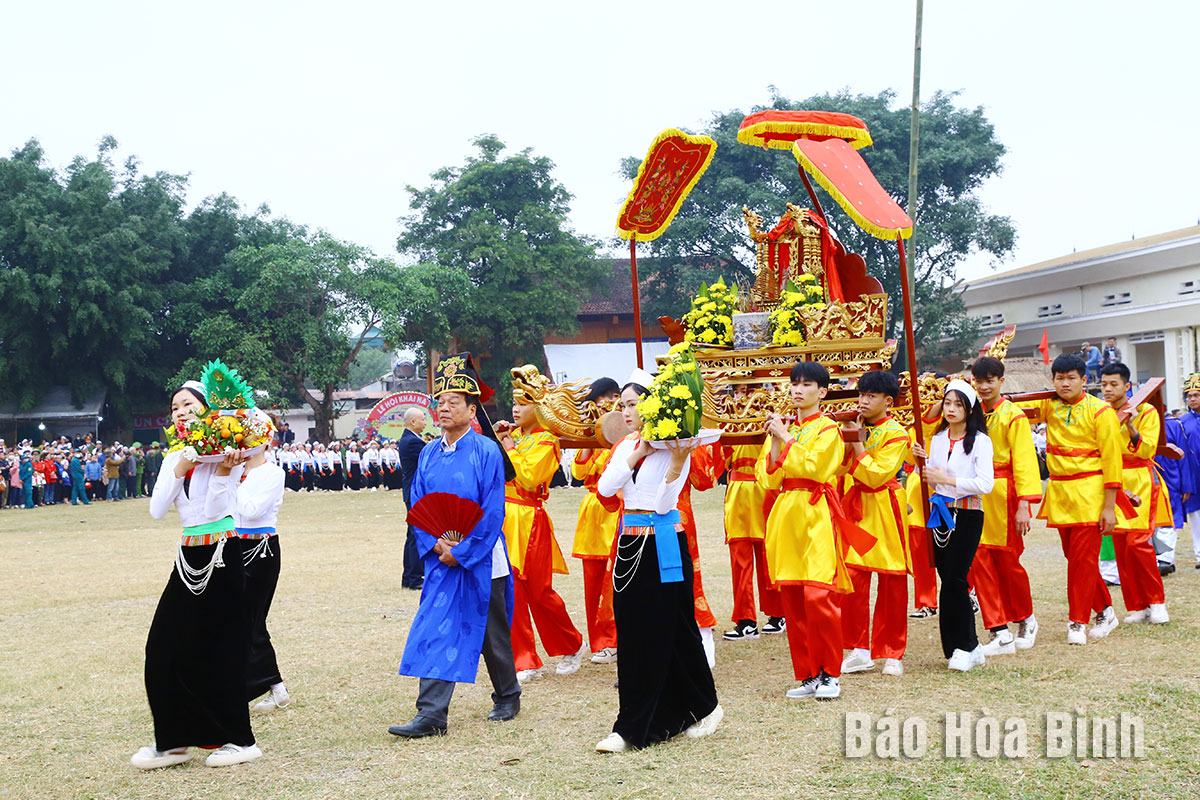Hoa Binh province has over 63% of its population being Muong ethnic people, who have created and upheld a diverse culture for generations. In that culture, Mo Muong is an outstanding and unique identity holding profound human values. Over the past years, the province has carried out a number of concrete and practical activities to preserve and promote values of this cultural heritage. The Government has submitted a dossier to UNESCO to seek the inscription of Mo Muong into the list of intangible cultural heritage of humanity in need of urgent safeguarding.
Bui Van Lung, a
Mo shaman in Luy Ai hamlet of Phong Phu commune (Tan Lac district), performs a
ritual at the 2024 "Khai ha” Festival of the Muong ethnic group in Hoa Binh
province.
Mo Muong is a great invention of the Muong
people and forms the essence of almost all the values constituting the Muong
culture in terms of history, literature, society, arts, belief, and daily life.
It clearly reflects Muong people’s worldview and outlook on life that need to
be treasured and preserved. Some also considered Mo Muong as a folk
encyclopedia about the Muong people that hasn’t been fully studied or
understood.
Mo Muong in Hoa Binh consists of rituals,
prayers, and performances practiced by Mo shamans. At present, people in
various Muong-inhabited areas in the province mainly practice five folk
melodies, namely O hoi, Da de, Ham mo, Da doong, and Heu keu.
Mo Muong was created a long time ago, and no one
knows exactly when it dates back to.
Meritorious Artisan Bui Huy Vong, a folk culture
researcher in Huong Nhuong commune of Lac Son district, said each area has a
different legend about the origin of Mo shamans. Mo Muong is a job that came
into being when social stratification took place in the Muong society. The
shamans are believed to possess extraordinary capacity helping connect the
living and the dead. They are also reputable persons in communities.
Mo is closely associated with the life cycle of
a person. When a baby was born, Mo is practiced to wish the child eat well and
grow well. When a person reaches adulthood, a Mo shaman holds rituals at
his/her wedding, housewarming celebrations, or ceremonies praying for good
health and safety. At village festivals, locals practice Mo to pray for good
weather and bumper crops. Besides, when a person passes away, a shaman acts as
a bridge helping the soul of the deceased reach the afterlife.
However, Mo used to be considered a superstition
and banned for a long time. Meanwhile, Mo artisans decreased and the young were
also not interested in this heritage. That led to degradation of many of its
traditional values.
At present, Mo Muong has undergone many big and
positive changes. Domestic and international scholars have conducted many
cultural, literature, and anthropological studies to shed light on its values,
thus further enhancing this heritage’s vitality in the life of the Muong ethnic
group.
As one of the first eight people in Hoa Binh to
be granted the Meritorious Artisan title (in 2015), Bui Van Lung, a Mo shaman
in Phong Phu commune of Tan Lac district, has long been dedicated to the
popularisation of Mo Muong. He was born in 1957 to a clan whose members have
served as Mo shamans for nine generations.
Lung said he loved listening to Mo even when he
was small, but it was not until the age of 25 did he officially start to learn
the work of a shaman, and he began doing this job at the age of 27. The shaman
added that he has visited various places to use Mo Muong to pray for people’s
happiness, give advice about the daily life to them, and perform rituals at
weddings, funerals, housing building ceremonies, local festivals, as well as
large events of the province.
After centuries, Mo Muong is still maintained in
the life of Muong people as well as other ethnic groups in Hoa Binh province at
present. Generations of the Muong people have preserved, orally passed down to
younger generations, and sustainably promoted Mo Muong’s values, thereby
fostering the vitality and strong ripple effect of this extremely valuable
intangible cultural heritage.



